
Search
The Renewable Energy site for Do-It-Yourselfers
An Experimental Copper/Aluminum
Solar Water Heating Collector
|
These pages cover an experimental
solar collector for heating water that uses aluminum heat absorbing fins and
copper pipes for conveying the heat transfer fluid. The key to good
performance in this design is a good thermal connection between the aluminum fin
and the copper pipe -- a lot of attention is given to providing this good
thermal bond.
The aims of the collector are to: 1)
performance that is very close to commercial collectors, 2) low cost - perhaps a
quarter of commercial collectors, 3) long life, and 4) easy construction using
readily available materials.
|
|
Directory
|
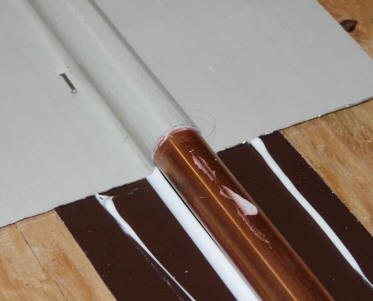 |
Copper/Aluminum Collector Concept
Solar water heating collectors are
used to heat water for domestic use and also to provide hot water
for space heating. The most common commercial collectors consist of
copper fins that are soldered or welded to copper pipes.
In operation, the sun heats the fins, which in turn transfer their heat to the
copper pipes and then to the water flowing through the pipes. This is a
good design that works efficiently and has a long track record. But, the design, does have some
drawbacks from a build-it-yourself viewpoint: 1) the materials have become very
expensive, 2) soldering or welding the copper pipes to the fins is time consuming and not a
common DIY skill.
| |
Note that the recent drop in
copper prices have made the
copper collector more attractive.
The copper collector now costs about $5 per sqft compared to the
$6 per sqft when this was first written.
April 4, 2009 |
This design uses aluminum fins instead
of copper fins over a grid of copper pipes. Since the
thermal bonding of the aluminum fin to the copper pipe is a potential thermal
bottleneck, every attempt is made to provide a good thermal bond.
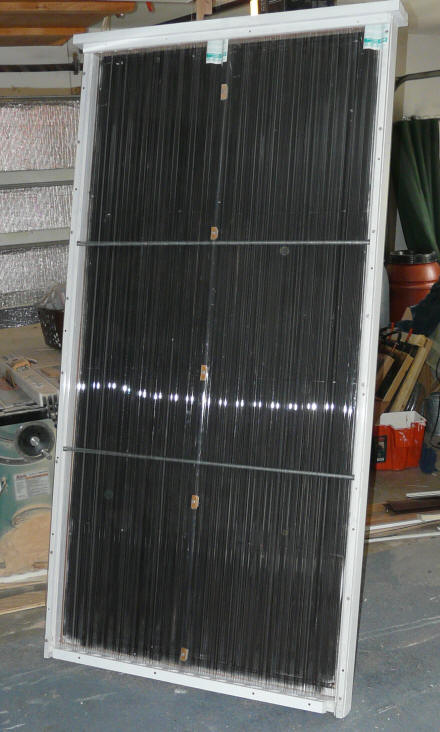
The finished, full size, prototype collector using copper tubes and
aluminum fins.
Some overview pictures -- see the
Construction section for much more detail.
|
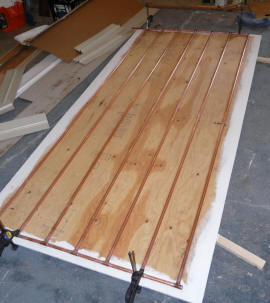
The copper grid -- using copper pipe. |
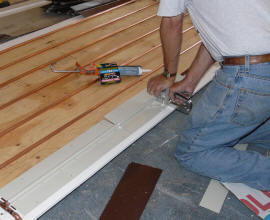
The aluminum heat transfer fins
that transfer absorbed solar heat
to the copper tubes. |
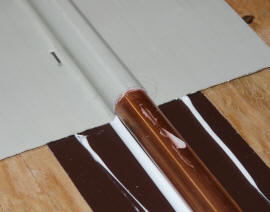
The key to good performance without
soldered or welded fins is lots of
heat transfer area, and very good
thermal contact. |
The potential advantages of this construction:
- The collector is easy to build using ordinary tools and skills -- its a
fairly easy DIY project.
- The collector is about 1/4 th the cost of commercial collectors (a
saving of about $700 on a 4X8 collector)
- Materials to build the collector are locally available -- the cost and
hassle of shipping large assembled collectors is avoided.
For one case I looked at, shipping on a commercial collector was nearly as
much as the total cost of materials from the collector.
- Compared to the PEX collector,
this collector offers better performance, and is more resistant to the
effects of high stagnation temperatures, but the materials cost more.
The build time is about the same.
Prototype Construction Details
The construction is very simple.
-
The frame is made with 2 by 4's
and a 2X6 for the top plate.
-
The glazing is corrugated SunTuf
polycarbonate ($1 per sqft at HD)
-
The absorber is built on a sheet
of plywood. The copper pipe grid secured to the plywood, and then the
aluminum fins are applied over the copper pipe grid and stapled tightly in
place using silicone to fill any tiny gaps and provide better heat transfer.
-
A sheet of polyiso
insulation is set into the back of the frame to insulate the back.
Much much more on the
construction here ...
Prototype Performance
Some day long performance tests of the full size prototype copper/aluminum
collector are here ...
These
small panel tests of the
copper/aluminum collector as well as the PEX/aluminum collector and the
traditional all copper commercial collector construction give a better idea of
how the performance of the copper/aluminum collector compares to other collector
designs.
Cost of Prototype
Note that the reduction in cost of
collectors is the result of a number of factors:
- Aluminum is cheaper than copper
- Polycarbonate glazing is
cheaper than glass
- The cost of truck shipping is
avoided.
- You don't have to pay yourself
any wages.
Cost for the 4X8 ft prototype -- using all
new materials:
| Item |
Quantity |
Unit Size |
Unit Cost |
Total Cost |
| SunTuf Corrugated polycarbonate glazing |
2 |
2X8 ft |
$18 |
$36 |
| Framing 2 by lumber (studs) |
|
|
|
$10 |
| Plywood or OSB absorber backing |
1 |
4X8 ft |
$10 |
$10 |
| Atlas R-Board polyisocyanurate insulation |
1 |
4X8 ft |
$16 |
$16 |
| Aluminum absorber fins |
32 sf |
|
$1 |
$32 |
| Copper pipe |
60 ft |
|
$1.00/ft |
$60 |
| Copper fittings (mainly T's) |
|
|
|
$14 |
| Silicone |
3 tubes |
|
$3/tube |
$9 |
| Screws, paint, wiggle strips, ... |
|
|
|
$10 |
| Total |
|
|
|
$197 |
A bit over $6 per sqft.
All of this adds up to a 4X8 ft
collector that cost about $200 rather than $600 to $900 plus shipping that may
run $150 ish.
| |
Note that the recent drop in
copper prices have made the
copper collector more attractive.
The copper collector now costs about $5 per sqft compared to the
$6 per sqft when this was first written.
April 4, 2009 |
Protecting the Collector From
Overheating
This collector uses all high
temperature materials and does not need any special protection for stagnation
conditions. I still think that is a good thing to not leave collectors
stagnated for extended periods (as do commercial collector manufacturers).
So, try to protect your collector in some way if you can -- shade cloth, high
tilt, use the heat for something...
Stagnation Test ... (for PEX collector, but should be very similar)
Drainback Test
On the PEX collector, I did a drain
back test with clear tubing just to make sure that its serpentine tubing layout
would drain well.
This copper/aluminum collector should have no
drain back issues, and with the half inch risers should drain back very
reliably. When I did the leak test in the shop, at the end of the test I
opened the valve at the bottom to let the fluid in the collector drain into a
bucket, and it drained with great gusto.
As with all drain back systems, the
collectors and the collector plumbing should slope toward the storage tank.
Tentative Conclusions and Remaining
Issues
Compared to the PEX collector, this
version that uses copper instead of PEX tubing offers better
performance, and more resistance to stagnation temperatures at an additional
cost of about $50. For most people I think this is probably the better
choice between the two.
Additional Possibilities
While I have talked mostly about
using this collector for domestic solar water heating, it would also be fine for
things like winter space heating, hot tub heating, and even pool heating into
fall and winter in cold climates.
One space heating possibility would
be to integrate the collector into your south facing wall. This
would reduce the cost and material use for both, and (I think) should save some
money and be a good use materials.
Bear in mind that this collector
could be built in just about any shape you want to. It could be used to
fit odd spaces you may have available. I suppose that even triangular,
trapezoids, and circles might be possible -- collector art :)
I suppose you could even go around
obstacles with it, just leaving a hole in the collector for the obstacle (e.g.
roof vent pipes).
I think that large collectors might
be a good way to go (e.g. build a single 64 sqft collector rather than two 32
sqft collectors. But, the larger sizes do get heavy and awkward to handle,
so make sure you have a way to move it into position when you are done (or build
it in position).
Example Solar
Water Heating System using this Collector
For an
example of a simple solar water heating
system that could use this collector, go here...
This is my solar water heating
system, and it uses the PEX versions of the collector, but the copper versions
described here would work even better.
While this system uses a collector of
about 48 sqft, a copper/aluminum collector would only require about 40 sqft to
achieve the same performance.
The system was put in place in
September of 2008 -- full details on how its is performing are at the link
listed above.
Gary September 23, 2008, September
29, 2008, October 4, 2008

